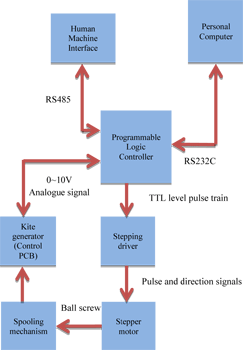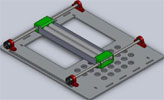
The higher in altitude the more constant and stronger wind energy is available. This paper presents the latest technology in wind energy harvesting, namely wind kite power generators. An overview is given on the kite power concept. Also a brief explanation is given on a project design and results obtained. Lastly, the advantage and disadvantage of wind generators, as well as future developments, are mentioned.
Introduction
South Africa has an intensive energy economy with a current usage of 4000 PJ primary energy and a carbon dioxide (CO²) emission of 8381 437 tons per annum[1] and it will be in our own interests to invest in the development of renewable energy.
Most commonly used sources to generate renewable energy include; biomass, solar, hydro and wind. Wind has gained purchase as the most economical method so far of generating renewable energy. However, conventional wind turbines do not harness the full potential of wind energy as they cannot access the faster, more constant wind at higher altitudes, as there are physical limits to how high a turbine can be built. Harnessing this energy from higher altitudes may be feasible with kites, or kite generators. Also the total potential wind energy available from higher altitude winds is estimated to be eight times that of all conventional wind turbine sites[2].
The Center for Instrumentation Research at the Cape Peninsula University of Technology (CPUT) has been researching kite power generators for the past six years. Although there has been a flurry of research into kite generators over the past two years, there is a huge lag in this very important technology amongst southern African countries. From an Airborne Wind Energy Conference held at Stanford University in the USA (September 2010), it was clear that the kite power concept is been well known to countries like the Netherlands and Germany.
Kite power concept
The kite power concept consists of a kite attached to line which can fly high into the atmosphere. Generally a line made of Dyneema is used for kite applications, because of its high strength to weight ratio and very good loading/unloading characteristics. The line is wound around a drum and as the wind attacks the kite, a pull out force is generated, causing the drum to turn. The drum is connected via a fixed gear ratio to a generator axis and this allows the generator to convert the kinetic energy into electricity. When the kite reaches maximum reeled out position, its pitch is changed and the angle of wind attack changes. The generator will then pull the kite back to ground. This reeling of line in and out is known as unwinding and rewinding of line.
![Figure 1: Kite power concept<sup>[3] [4]</sup>](articles/SA Instrumentation & Control - Published by Technews/whitei&cnf31jan12a.png)
The following factors are important when setting up any unwinding or rewinding system namely; line speed, line tension, winding direction and spooling pitch. The most common one which is visible in almost every industrial environment is direction and it happens all the time, only in one direction. The line is only either winding onto the drum, or winding off the drum. For the kite power concept to work, it has to go in both directions (almost instantaneously) at much faster speeds and also at much higher tensions than these general winding applications.
Project objectives
The main objective of this project was to design, build and test an effective control and spooling mechanism for a 20 kW portable wind kite power generator in order to guide a line via a spooling mechanism onto a drum. The most important specification for the controller unit to meet was the line speed and drum velocity. It must be capable of operating the spooling mechanism up to a line speed of 15 m/s. The second most important object was to provide a user friendly interface to an operator to be able to interface easy and conveniently with the kite even at high altitudes. A relatively cost effective control system together with a spooling mechanism has been successfully developed and implemented.
Project methodology
It was decided that a constant current stepping driver and stepper motor would take control of the mechanical spooling mechanism, because it was the more cost effective method. To control the stepping driver, a programmable logic controller (PLC) with two high speed digital inputs and build in axis synchronisation, provided to be the most robust and easiest to setup. It provides two driving signals namely; direction and pulse. With this open collector transistor configuration outputs on a level of 24 Vdc, it acts as the perfect intelligent motion controller. To provide the PLC with feedback from the main drum on how much line is reeled out and how much is left, an open collector type digital rotary encoder with a hollow shaft was connected onto the drum’s shaft.

The PLC in conjunction with the stepping driver synchronised the main drum and the spooling mechanism. It provided a consistent smooth and neat layer of winds on the drum and allowed more versatility, in terms of tuning it to different line widths, lengths, drum widths etc. The PLC also outputs a 0~10V linear digital to analogue signal for line tension control to the power electronics controller PCB. The PLC chosen supports three of the five IEC 61131-3 standard programming languages namely; ladder diagrams (LD), structured text (ST) and sequential flow charts (SFC). Although LD is not the most advanced software development language available, it makes fault finding and maintenance on the control system easy, as most industrial engineers understand the language very well.

Results
Not only did the controller provide the synchronise function, but it was far more advanced than any given mechanically synced system. A human machine interface (HMI) (5,7 inch touch screen) was connected via a serial communication network topology to the PLC and allows the operator to interface seamlessly and quickly with the generator. It has functions like; line speed, line tension, drum angular velocity and many other features.
The spooling mechanism design and development was only one part of the complete project undertaken and is not yet completed. Obtaining results was difficult and had to be considered as individual results, because this is only a section of the bigger picture and project.

The main object of the tests conducted, was to insure that the spooling mechanism is working properly and according to specifications for the upcoming complete project tests in the nearby future. Results obtained includes, control panel power consumption and pitches of the HMI.

Conclusion
A wireless connection between the control panel and the kite in the air is needed to change the pitch of the kite. This will allow the control panel or PLC to take full control of the line tension automatically, by varying the kite pitch wirelessly.
One of the biggest advantages of wind energy generation is that it does not produce radioactive, hazardous or polluting waste as to what biomass does. The biggest disadvantage is that the wind kite generator technology is still in its early stages and lots of research and development still needs to be done to be used commercially.
After a 3G virtual private network (VPN) connection is established between the controller and a centralised control centre, it will be a good idea to create a Microsoft SQL database, which can log the winch operation conditions. This will allow for report writing facilities in SQL reporting services (SSRS), which contains parameters like trends and history alarms. All of this information can then be used in future development of kite generators.
The research done will not only benefit wind energy generation, but also any winding and unwinding applications in the manufacturing industry. This is purely due to many older mechanical synchronisation systems being replaced with advanced electrical/electronic systems. This research and project can definitely be seen as a step forward towards the first kite power generator on African soil.
References
[1] D. Banks, J. Schaffler, ‘The potential contribution of renewable energy in South Africa’, February 2006, URL http://www.eepublishers.co.za/article/the-potential-contribution-of-renewable-energy-in-south-africa.html[2 June 2009].
[2] M. Brooks, ‘High flyers’, New Scientist Journal, Issue 2656 pp. 38-41, May 2008.
[3] A.R. Podgaets and W.J. Ockels, ‘Robust control of laddermill wind energy system’, Proceedings of the Wind Power Shanghai Conference, Shanghai, China, November 2007, URL http://www.lr.tudelft.nl [21 November 2008].
[4] B. Lansdorp and W.J. Ockels, ‘Design and construction of a 4kW groundstation for the laddermill’, IASTED, European Power and Energy Systems (EuroPES) Conference Proceedings, August 2007, Palma De Mallorca, Spain, URL http://www.actapress.com [10 May 2009].

© Technews Publishing (Pty) Ltd | All Rights Reserved